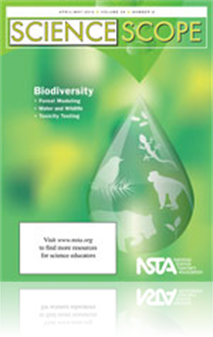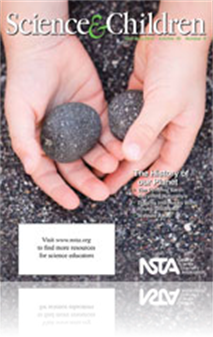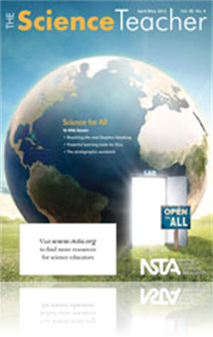All Resources
Book Chapter
Teacher Guide for Let's Diagnose Them, Lab 1: Urinalysis
In medical school, students learn about the excretory system and its urinary track. In this chapter, four patients have submitted urine samples. A urinalysis can determine the state of one’s health by examining physical and chemical properties of ...
Book Chapter
Teacher Guide for Let's Diagnose Them, Lab 2: Digestive By-Products and Body Mass Index Analysis
In this chapter, two of the four patients experience digestive issues. A team of doctors will run tests on the digestive by-products of these two patients, while the students will be expected to formulate an even deeper hypothesis about the condition...
Book Chapter
Teacher Guide for Let's Diagnose Them, Lab 4: HIV Test
In this chapter, based on blood samples recently analyzed, one of the four patients has a very low white blood cell (WBC) count. This is alarming since it might indicate the patient is suffering from a viral infection. Since all of the patients reque...
Book Chapter
Teacher Guide for Let's Diagnose Them, Lab 5: Lung Capacity
In this chapter, all four patients experience difficulty breathing. Students will determine the lung capacity of each patient using a spirometer, which requires the patient to exhale deeply in order to determine if diseases such as asthma, pneumonia,...
Book Chapter
Teacher Guide for Let's Diagnose Them, Lab 6: Hormone Test
The endocrine system produces hormones that help regulate the body’s internal organs. Hormones are chemical messengers sent through the bloodstream and when too little or too much is produced, it is often an indication that something is wrong. In t...
Book Chapter
Teacher Guide for Emergency! Lab 7: Performing Surgery
In this chapter, doctors are unsuccessful in reviving a patient who is an organ donor. The students are called upon to perform the donation surgery, with the job of identifying and removing various organs from the patient’s body. In the United Stat...
Book Chapter
Teacher Guide for The Ominous Phone Call and Evaluating the Docs
A diagnosis for each of the four patients has finally been developed. Before releasing them from the hospital, students must complete the medical charts and provide the pharmacist with the information under the sections “Diagnosis,” “Treatments...
Book Chapter
What Are the Challenges for STEM Education?
This chapter discusses contemporary challenges of STEM education. The chapter describes several challenges and presents a model introduced in earlier publications—the 4Ps of purpose, policy, programs, and practice—as a way to understand the vario...
Book Chapter
What Can We Learn From the Original Sputnik Moment?
This chapter reviews the Sputnik era—a significant turning point for the STEM disciplines—and reforms of the STEM disciplines. The chapter includes the historical discussion of the national mission and insights specific to educational reform beca...
Book Chapter
Is STEM Education a Response to This Generation's Sputnik Moment?
This chapter sets the stage for the remaining chapters by describing several unique features for the STEM reform. The chapter addresses the themes of globalization and current STEM-related issues, 21st century workforce skills, and the continuing pip...
Book Chapter
STEM Education Seems to Be the Answer—What Was the Question?
Here, the question seems to have been, “What do we need to develop a knowledge economy?” The answer is to focus on the STEM subjects—science, technology, engineering, and mathematics. This chapter directs attention to 35 reports and publicatio...
Book Chapter
If STEM Is an Opportunity, What Is the Federal Government's Role?
This chapter presents five policy recommendations for the Federal Government, and is a response to a federal mandate to review STEM initiatives across federal agencies and coordinate, if not consolidate, various programs. The chapter provides an oppo...
Book Chapter
How Can a State, District, or School Develop a Coherent Strategy for STEM Education?
This chapter presents a framework and concrete way to begin thinking about STEM programs and practices. The chapter identifies a general question about the purposes of STEM education and proposes answers to the question setting the stage for leaders ...
Book Chapter
What is Your Perspective of STEM Education?
This chapter presents different perspectives of STEM education. The goal is to clarify and not confuse the issue of STEM. These perspectives are based on many discussions, articles, reports, and projects where there is reference to STEM. The author h...
Book Chapter
STEM Education: Where Are You Now, and Where Do You Want to Go?
This chapter addresses a critical point—when taking a programmatic curricular view, does STEM imply an integrated perspective? This chapter begins with a view of separate STEM disciplines and progresses to a variety of ways that the STEM discipline...
Book Chapter
What Is Your Action Plan for STEM Education?
This chapter will help you develop an action plan by considering critical factors such as the unit of change, resources, components, and support for STEM education. The plan should address the way you initiate, implement, bring to scale, and sustain ...
NSTA Press Book
The Case for STEM Education: Challenges and Opportunities
If you’re an education leader concerned with science, technology, engineering, and mathematics (STEM) initiatives, this book will help you both understand and implement STEM action plans. The book starts by putting STEM in context, as the early cha...
By Rodger W. Bybee
NSTA Press Book
Diagnosis for Classroom Success, Teacher Edition: Making Anatomy and Physiology Come Alive
“When I entered the teaching profession, I was stunned by the lack of interest my high school students had in science education. The traditional model of teaching science, often referred to as ‘chalk-and-talk’ with the occasional laboratory mix...
By Nicole H. Maller
NSTA Press Book
Including Students With Disabilities in Advanced Science Classes
Are you an experienced science teacher who needs a foundation in special education basics when students with disabilities are placed in your advanced classes? Then this book is the resource for you. Both practical and readable, this book will help yo...
By Lori A. Howard, Elizabeth A. Potts
Journal Article
Ecological Investigations Within an Interactive Plant Community Simulation
This article describes how students can create a virtual plant community that uses simple ecological models of plant species to simulate changes in a plant community over time....
Journal Article
Build your own fish, amphibian, and reptile models to explore the diversity of life....
Journal Article
Journaling: A Bridge Between School and Home
Children share their learning experiences while using academic language in a meaningful way....
Journal Article
Enhancing Science Kits With the Driving Question Board
This article describes a tool to increase student engagement, clarify connections between activities, and align to standards....
Journal Article
Tried and True: Simulating Biodiversity: The Effects of Human and Environmental Factors
This column provides classic demonstrations and experiments with a new twist. This month’s issue discusses a simulation-type game where students can quickly see how various factors—small and large, human-dominated and natural—affect a community...
Journal Article
Editor's Corner: Science for All
The Science Teacher’s editor shares thoughts on the current issue....
Journal Article
The <i>Next Generation Science Standards</i> and the Earth and Space Sciences
This article examines the important features of Earth and space science standards for elementary, middle, and high school levels....
Journal Article
Formative Assessment Probes: Is It a Rock? Continuous Formative Assessment
This column focuses on promoting learning through assessment. This month’s issue discusses assessment related to Earth Science topics of rock formation and properties of matter....
Journal Article
Reaching the Next Stephen Hawking
This article offers five ways to help students with disabilities in advanced placement science classes....
Journal Article
Teaching Through Trade Books: What Shapes the Earth?
This column includes activities inspired by children’s literature. This month’s issue explores the question: How and why is Earth constantly changing?...
Journal Article
This Q&A style column provides up-to-date information on current health topics—helping students (and teachers) make healthy choices. This month’s issue helps students understand the consequences of concussions....
Journal Article
Using Mathematics to Conduct Social Analyses of Bottlenose Dolphins in Science Classrooms
Observe dolphin social interactions in an interdisciplinary math and life science unit....
Journal Article
Scope on Safety: Sizing Up for Safety
This column shares safety information for your classroom. This month’s issue discusses occupancy load....
Journal Article
The <i>Next Generation Science Standards</i> and the Earth and Space Sciences
This article discusses the important features of Earth and space science standards for elementary, middle, and high school levels....







